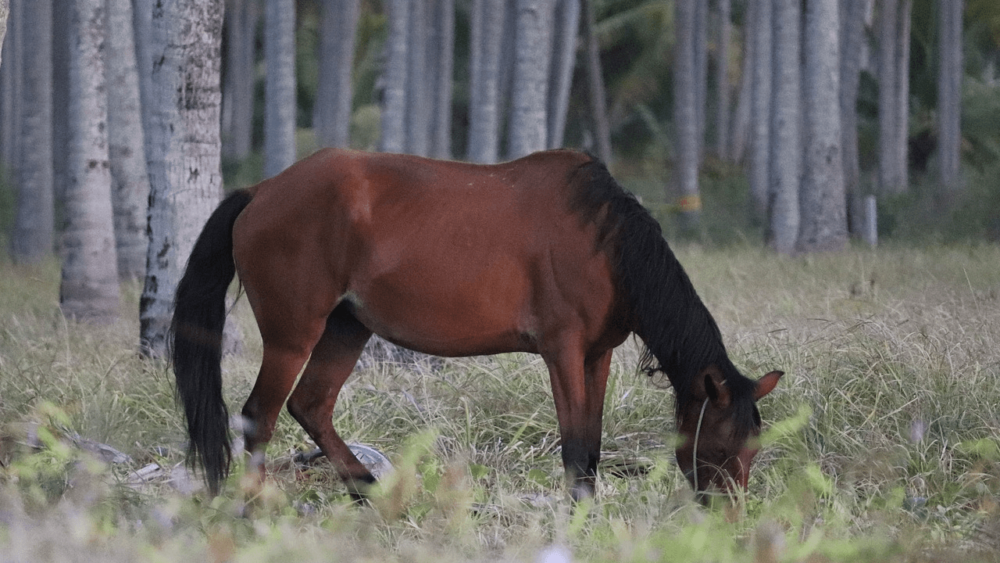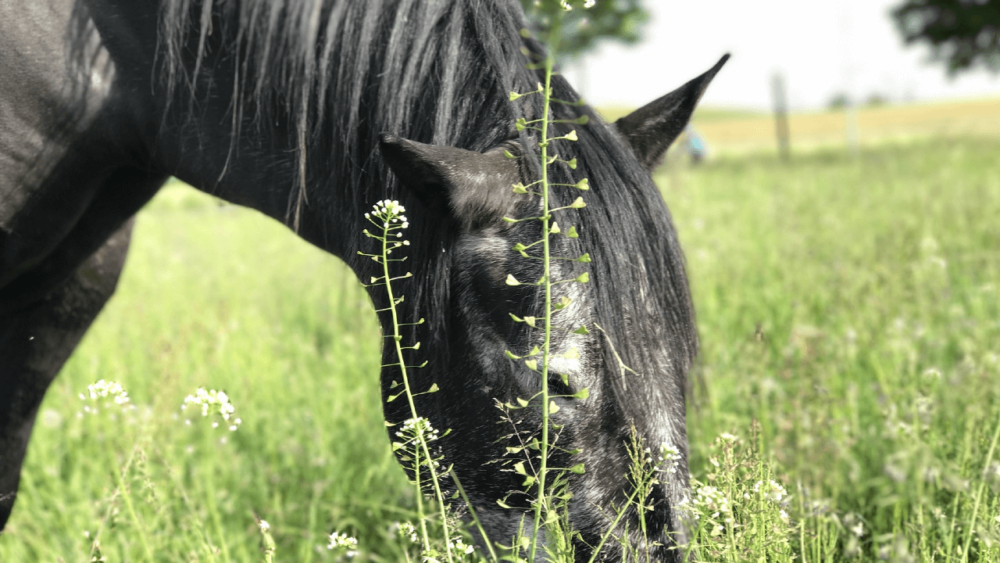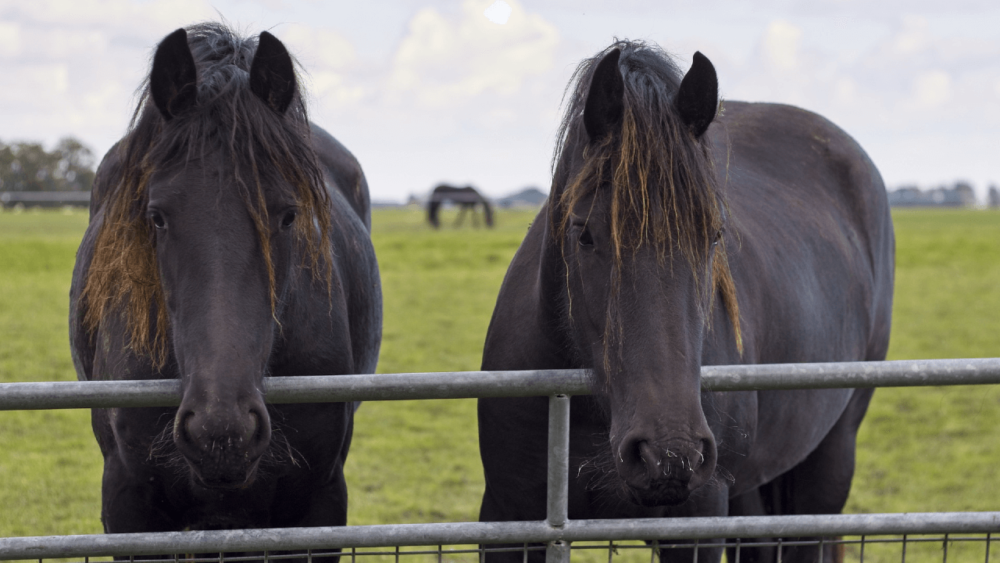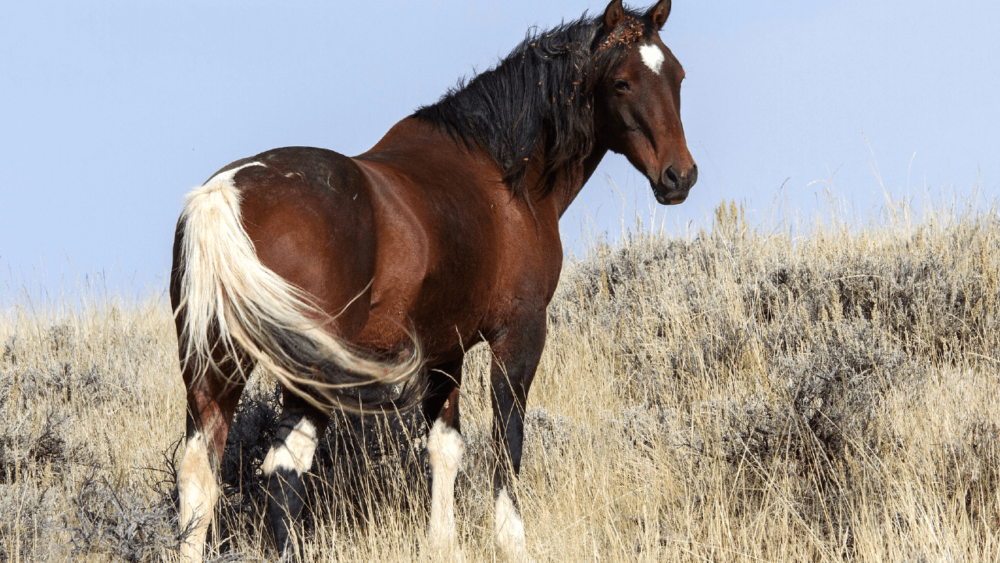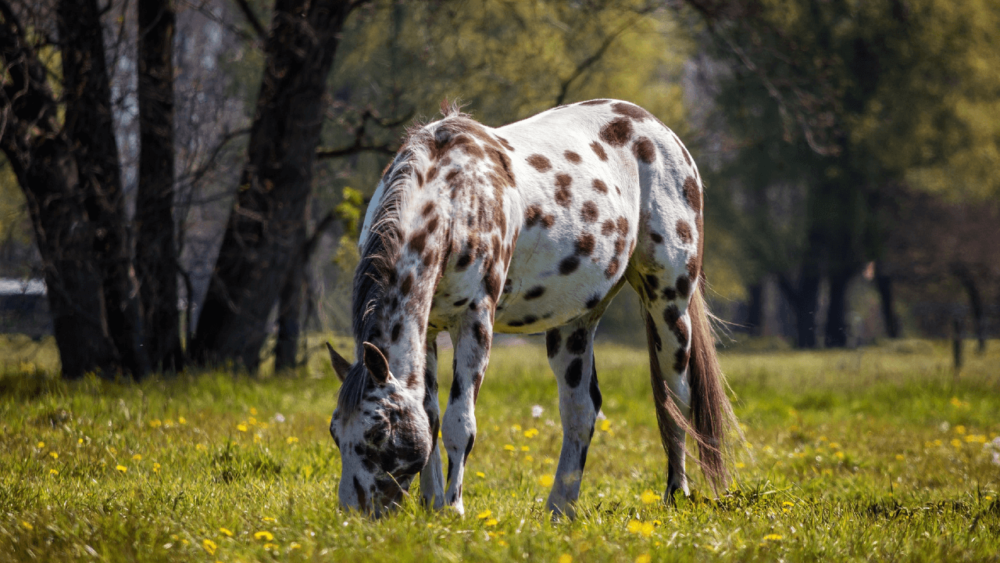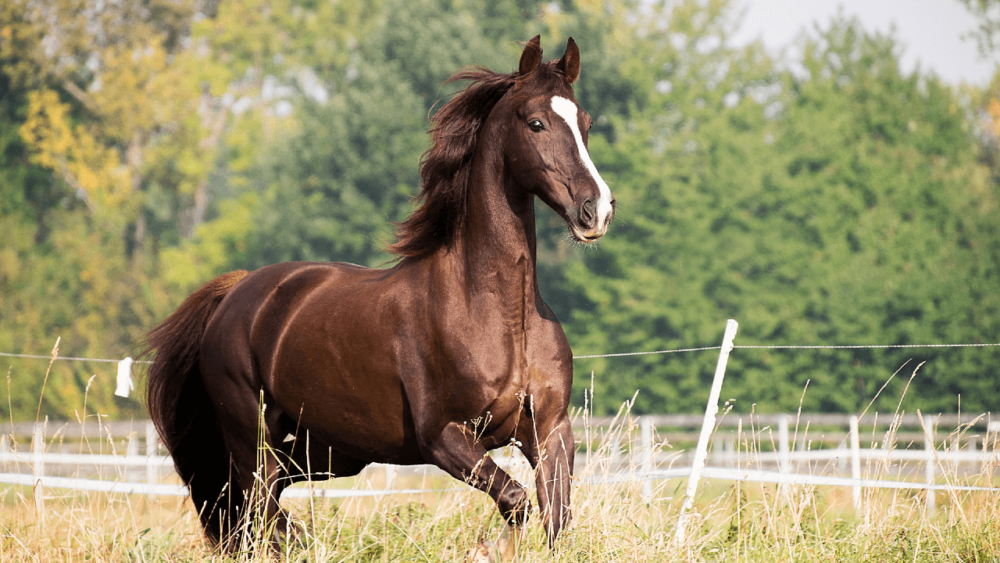After a few riding lessons, it’s natural to start considering getting your own horse to care for and bond with. Owning a horse is a big undertaking in financial investment, time, and responsibility.
Many people get fixated on the cost of the horse, overlooking the costs associated with keeping that horse fit and happy. Few of us would look a gift horse in the mouth but what looks like a cheap deal often comes with hidden costs.
How Much Does a Horse Cost in the USA?
In the United States, horses cost between $300-400 dollars to adopt a “free horse” and as much as $10-15,000 for trained or registered horses. Even free horses usually have an unseen cost. Many factors go into the price of a horse.
Horses with specific bloodlines or genetics will go for a substantially higher price than similar horses without those bloodlines. In addition, the color, age, gender, breeding abilities, training, and disposition all affect the price of a horse. And, there are additional external factors that will affect the price.
https://www.youtube.com/watch?v=aLiFmi2EfMY
Let’s dive in.
Horse Breed and Bloodlines Greatly Affect Horse Price
A six-month-old weanling of unknown breeding costs as little as $500. However, a pure Spanish Andalusian with proven bloodlines will cost you closer to $35,000. Purebreeds cost more than mixed breeds. Horses that are purebred Spanish Andalusian, Hanoverians, Warmbloods, and Gypsy Vanners carry price tags in the $25,000 to $50,000 range. Purebred horses have recorded lineages that prove the horse doesn’t have genetic from other breeds except it’s breed.
Breeding also plays a part in the cost of a horse. Thoroughbreds are some of the cheapest if you adopt a retired racehorse and some of the most expensive. You may think a thoroughbred horse is the same as a purebred, but that isn’t the case.
Thoroughbred horses are used specifically for racing and is a specific breed. A well-bred Thoroughbred with eventing experience, for example, can cost anywhere $30,000 and up.
Contrast that with a horse that isn’t used for racing but primarily used for pleasure. The average price paid for a pleasure horse is around $2,500. But Thoroughbreds aren’t the only expensive horse. There are many things to consider when you evaluate a horse to buy.
The 10 Most Expensive Horse Breeds
Around the world, ten horse breeds tend to cost more than other breeds. The most expensive horse breeds are:
1. Akhal Teke
Akhal Teke horses usually cost $10,000 to start. Training, age, reproductive health, and pedigree can raise the price of Akhal Teke horses by another $10-30,000. While $10,000 is the average price for an unregistered Akhal Teke horse, many registered, trained Akhal Teke horses sell for as much as $40,000 in the United States.
Purebred Akhal Teke horses are harder to find in the U.S. Additionally, many seek a shiny, metallic coat for this breed.
2. Dutch Warmblood
On average, Dutch Warmblood horses cost $5,000-$35,000 in the United States. Some Dutch Warmbloods with strong bloodlines, fantastic jumping records, and show history have commanded over a million dollars. Strong lineage with champion bloodlines can cost $100,000-200,000. Dutch Warmbloods used primarily for private use often cost about $5,000-15,000.
During World War II, the Dutch Warmblood originated in the Netherlands as a warm-blooded horse that was bred to be strong enough for farm work and beautiful for pleasure sports. The Dutch Warmblood replaced its parental breeds, the Gelderlander and Groningen breeds, in popularity. Today, there is some dispute over whether the Gelderlander and Groningen breeds still exist in their original lineage.
3. Andalusian
Andalusian horses command as much as $50,000-$65,000 for show-ready horses. Regular-use and private use Andalusians usually cost $10,00-$15,000. You may occasionally find them as low as $3,000-$5,000 if they have some mixed parentage. Andalusians are called the Pure Spanish Horse Breed and were used in historic times for war and as a show of power.
Andalusians can come white, grey, or bay-colored. They also come in other colors, including black, dun, palomino, and other colors. Andalusian paintings show that they had an even broader array of coat colors historically. During medieval times, Andalusians were a favorite of royalty. They decend from the oldest breed in the world, the Iberian horse.
Napolean stole most of the Andalusians in Spain, and both helped to spread their popularity in Europe and simultaneously threatened the breed’s purity. Fortunately, one herd of Andalusians was hidden from Napoleans’s army and was used to revive the breed. As a result, most Andalusians are a variation of grey or white mix.
4. Selle Francis
Selle Francis horses usually cost between $15,000-$50,000. The highest-priced horse ever sold was a Selle Francis, which sold for 11 million Euros, equating to about 15 million US dollars. An unborn (in-Utero) foal of good lineage commands between $25,000-$35,000, depending on the gender. Buyers can find retired Selle Francis horses around the USA for as little as $1,000-2,000.
The Selle Francis breed was created in 1958 in France as a show horse. Several show breeds were combined into one studbook to create a uniform sport horse. Since that time, Selle Francis horses have been exported worldwide and stud books set up in the United States and Great Brittian. Few Selle Francis horses are used for only pleasure as they are mostly sport horses.
5. Hanoverian
Hanoverian horses cost $10-$25,000 for private use, but show Hanoverians command between $45,000-$95,000 in the U.S. Younger, more inexperienced show horses usually cost between $35,000-$50,000, while experienced show horses cost $55,000-95,000. Retired and older Hanoverians can cost as little as $5,000-10,000 apiece.
Hanoverians originated in the Kingdom of Hannover as part of Great Brittian in the 16th Century. By the 1800s, the breed was considered refined, and Hanoverian became part of Germany. It was initially bred as a war and carriage horse. The Hanoverian has emerged as an athletic riding horse in the last hundred years.
6. Gypsy Vanner
Gypsy Vanner horses are rare in the United States, and so an average-use one will cost between $10,000-$25,000. Because they are rarer, lower-priced ones are harder to find and are usually mixed breed. Show Gypsy Vanner horses cost around $40,000-60,000. They are initially from the Romani people of England and Ireland. They are considered the “people-sized draft horse.”
Gypsy Vanner horses were bred by the Romani people, also called Gypsies, to pull their caravans. Until 1995, the traveling groups of Ireland and Scottland bred Gypsy Vanners and did not distinguish them as a separate breed. The breed and lineage were protected and kept within the “Gypsy” community. They sold off many horses each year but kept select, higher lineage horses for use within the community.
In 1995, an American couple, the Thompsons of Florida, saw a beautiful and mystical horse across a field. Upon further inquiry, the Thomspons found the owner and to the famous Appleby Horse Fair. At the fair, the Romani people, and other traveling groups, met to trade horses. The breed became official in 1996. Gypsy Vanner horses are beautiful with feathering on their legs that extend from the knees to the hooves.
7. Friesian
Friesian horses can cost as much as $500,000-600,000 for quality show stallions. But most Fresian horses cost between $5,000-$20,000 for a young or untrained horse. A show horse that’s a 2-3 years usually hold costs between $20,000-30,000. There are about 8,000 Friesians in the US, so they can be more challenging, but not impossible to find for sale.
Friesian horses were medieval horses that originated in Friesland, Holland. They were strong enough to carry heavily suited knights and agile enough to be used in battle. Roman soldiers mentioned mounted Friesian horses in 150 A.D. The breed almost became extinct in the years before World War I. But, since it has been revived as a fine carriage horse.
8. Lipizzaner
Lipizzaner horses are rare worldwide. In the U.S., there are under 1,000. Young, unbroken Lipizzaners sell for around $10,000, while trained horses sell for between $20,000-$30,0000. Show horses and those with exceptional lines sell for as much as $40,000.
Lipizzaner horses are one of the oldest European horse breeds. Europeans bred Lipizzaner horses for the exclusive use of the royal Hapsburg family. It descends from now-extinct breeds. Breed standards were developed in the 1500s. The Lipizzaner studs carry a two-part name identifying the sire and stud foundational lines.
9. Oldenburg
Oldenburg horses have a wide range of prices, depending on lineage, training, and gender. Common Oldenburgs can sell for as little as $10,000-$25,000 in the USA. Older Oldenburgs sell for as little as $4,000. But, show Oldenburgs often sell for well over $100,000 and often sell for as much as $550,000. These elite horses have strong pedigrees with performance history.
Oldenburg horses are considered the first of the warmblood horse breeds. They were primarily used in Germany as a work and carriage horse, but today are used as high jumping horses and for top dressage competitions.
10. Holsteiner
Holsteiner horses cost between $15,000-$45,000 on average. Older, retired Holsteiner horses can cost as little as $2,000-$5,000. Competition Holsteiners usually cost at least $25,000, and experienced ones can easily cost as much as $50,000-60,000.
Holsteiners originated in Northern Germany and were bred for 700 years with specific breeding requirements. They are incredibly agile and muscular. Bred initially by monks, the responsibility of the breed shifted to farmers and then to the German government in the 1700s. The government introduced rewards for the finest stallions that met certain conditions. After World War II, breeding ceased, and the breed was saved when the Federation of Breeders purchased thirty stallions and bred them to thoroughbreds, making today’s modern Holsteiner horses.
Gender Affects Individual Horse Price
While it’s reasonable to think that a foal without any training or experience will be cheaper than an older horse, that isn’t always the case.
The less you pay for a horse, the more you’re liable to pay in maintenance costs. An older horse, for example, is more prone to weight loss and may need a more expensive, specialized diet to keep it healthy.
Similarly, a young horse that has yet to be broken for riding may only cost a hundred dollars or so. However, getting a professional trainer in to complete its training could cost anywhere between $800 to $1200, excluding tax.
Gender Greatly Changes Price
Gender also affects the price of horses, especially foals.
Colts are usually cheaper than fillies, and you can quite easily find an Arabian, Quarter Horse, or Appaloosa colt for less than $3,000. Shetland ponies and Miniatures are amongst the cheapest, coming in at under $1,000. You may even get lucky and find a Thoroughbred colt for around the same price.
Although with many breeds, a colt is cheaper than a filly, certain breeds may command more for a colt than a filly. Selle Francis colts cost several thousand dollars more than a filly. One website sold unborn colts for $10,000 more than unborn fillies. However, this is an exception with only a few breeds as fillies are more costly than colts.
However, Colts will turn into stallions, making them difficult to home and handle. Few livery yards will be willing to take on an uncastrated horse. The United States Equestrian Federation also bars Stallions from competing in ladies’ or junior exhibitors’ classes.
Gelding a horse costs, on average, somewhere between $200 and $500. It’s worth considering this before buying a colt.
Prices of fillies start at around $1,500 for Arabians, Paints, and Appaloosas. At the top end, you’re looking in the region of $20,000 to $25,000. Andalusians, Hanoverians, and Warmbloods seem the most desirable, with Gypsy Vanners close behind.
Broodmares are often among the cheapest. Many are no longer ridable and maybe a little long in the tooth. An 18-year-old Thoroughbred, for instance, may even be accessible to a good home, while an older Quarter Horse or Arabian broodmare may cost as little as $500.
A good-quality stallion with stud potential is a costly yet potentially profitable investment. You could pay $30,000 or more for a stallion. If you then charge $600 for every mare, he covers, if there’s enough interest in his progeny, you could end up with a veritable gold mine. On the other hand, if he proves impotent, you may find you’ve overpaid the odds for an average performance horse.
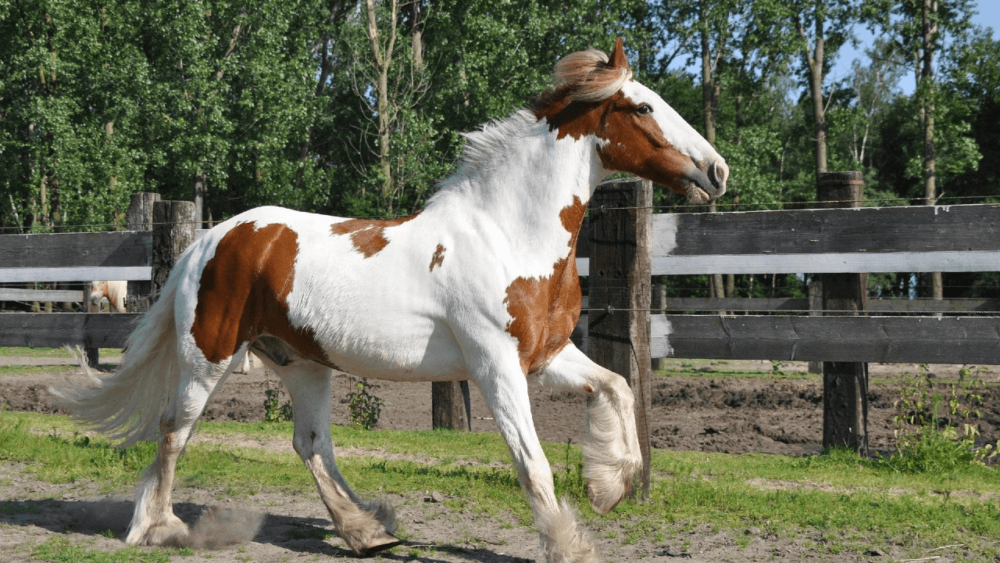
The Horse’s Color Affects Price
Color may not affect a horse’s performance, but it does influence the price.
In the racing industry, a bay horse is preferred over any other color. However, in pleasure riding, buyers are seeking out more unusual, eye-catching colors and are prepared to pay for the perfect look.
I have three-bay horses but often wish I had a pinto in there to mix things up a little. I’m not the only one. A study of the price determinants of stock-type horses, published in the Journal of Agricultural & Applied Economics last year, found that people are willing to pay more for a Tobiano or Overo colored horse than they are a bay or chestnut.
Black and grey horses tend to cost the least, while Palomino and Buckskin cost slightly more.
Ability, Training, and Discipline Influence Horse Price
Regardless of whether you’re looking for a show-jumper or stock horse, the more training the horse has, the higher the price.
Basic ground manners, such as walking on a lead, standing for a farrier, and being tied up and groomed, are valuable skills worth paying a few hundred dollars. Depending on age and breed, a horse with these basics in place usually costs between $1,500 and $6,000.
You could pick up a completely green horse or a Wild Mustang for a lot less, but you’d be facing a considerable challenge. Without the necessary considerable skill, experience, and dedication, a purchase of this nature could end in disaster and costly medical bills!
A horse with basic riding skills should walk, trot, canter, and halt comfortably under the saddle. He will need further training to prepare him for a specific discipline. As a result, his price will fluctuate between $5,000 and $10,000.
Prices increase according to the horse’s level of training and ability, with those that have already competed and proven themselves in a specific discipline costing more.
The table below will give you a rough idea of what you can expect to pay for a horse in nine of the world’s most popular horse-riding disciplines:
| Discipline | Lower price scale | Higher price scale |
| Barrel Racing | $12,500 | $25,000 |
| Dressage | $12,000 | $200,000 |
| Endurance | $6,000 | $12,000 |
| Eventing | $25,000 | $200,000 |
| Pleasure Driving | $1,500 | $40,000 |
| Polo | $5,000 | $30,000 |
| Reining | $30,000 | $45,000 |
| Showing | $15,000 | $45,000 |
| Showjumping | $60,000 | $200,000 |
Horses already performing at an international level in any discipline are, understandably, the most expensive. An International Grand Prix horse will cost you in the region of $100,000 to $200,000. The most expensive horse ever sold was a champion American Thoroughbred by Fusaichi Pegasus. In 2000, he sold at auction for a staggering $70m.
External Influences That Affect Horse Prices
Horse sales and prices boomed during the COVID-19 pandemic, with buyers willing to offer as much as $20,000 for a horse with basic schooling. One owner of a Maryland horse-boarding facility, Karen Fulton, said, “We saw people paying $20,000 for a horse that will walk and trot down the rail. In years past, that horse cost $2,500.”
The link between the restrictions enforced during the pandemic and increased horse demand may not be scientifically proven, but many see a connection.
Horse-riding is a naturally socially distanced sport because safety encourages us to keep a distance of one-horse length between horses when riding. It seems only natural that it would replace team sports and, as it’s an outdoor activity, offer a safer alternative to indoor pursuits.
People working remotely also had more flexibility in working hours and location. These factors made it easier to spend more time at the barn.
However, as restrictions ease, horses’ price is likely to stabilize.
However, on the other side of the coin, horse owners who lost their jobs or experienced a reduced income were forced to sell up. In Spring last year, The Humane Society of the United States provided funding to equine rescue centers to help them cope with the number of horses being surrendered to them due to owners being unable to afford feed and other expenses.
These factors have caused chaos in the horse market, making it difficult to predict the price and availability of horses.
The Price of Horses Fluctuate Based on Location and Country
The price of horses doesn’t vary much from state to state. If you start looking beyond the US, however, prices fluctuate immensely. In Mexico, you can pick up a riding horse for as little as Mex $3,000, the equivalent of $150.
In the UK, the average price is around £1,000, or 1,372.49, making it over $1,000 cheaper than buying one in the US.
Buying a horse from overseas may seem cheaper, but it invariably becomes more expensive when you add in the transportation and quarantine costs. Importing a horse from Mexico costs around $270 per day for a minimum of three days, so you need to add an extra $810 to the purchase price.
Importing a horse internationally is even more expensive. A one-way flight from Europe to the US costs between $7,000 and $10,000 for each horse. This makes it financially unfeasible for anything other than a top-competition horse.
The 10 Cheapest Horse Breeds in the USA
Wild Mustangs are among the cheapest horse breeds, and you can pick one up from the US Department of the Interior Bureau of Land Management Wild Horse and Burro Program for as little as $25. Some 4H programs help kids to train and sell these BLM horses. A Mustang trained and shows potential as a riding horse costs around $125.
That’s only the beginning, however. Many Wild Mustangs need extensive veterinarian treatment and training before they can even be considered for riding.
The top Ten cheap horse breeds include:
1. Wild Mustang
Wild Mustangs are untrained and have unknown genetics. Additionally, their health is strange because they were wild before being rounded up. But, for all of this, they can become great horses if you know how to break and train them. BLM adoption fees start around $25 for untrained horses and $125 for trained horses. The final cost can be a little higher, depending on the state.
The BLM manages the herds to keep them from overpopulating areas, which causes increased disease and starvation among the herds. Herds can double in size every 4 years. Adopting a Mustang helps preserve the herds’ overall health and keeps the lands they use in better condition.
The Mustang herds originate from Spanish horses that were brought to the Americas in the 1500s through the 1700s. If you want to purchase a fairly broken Mustang, many 4H programs around the country sell the broken Mustangs after 4H kids have spent a year training and breaking them. The sale proceeds help the 4H programs and benefit the specific child that worked with the horse you purchased.
2. American Paint
American Paint horses usually cost between $1,000-$3,500 for average American Paint Horses. Registered American Paint Horses tend to sell for between $8,000-12,000. Award and show American Paint horses can sell for as much as $20,000.
American Paint Horses were brought to North America by Hernando Cortes in 1519. The current breed descends from those early horses. Native Americans loved the paint coloring on the horses and some tribes believed they had mystical properties. As settlers traded and bred with Native American horses, the coloring was preserved until modern times.
3. Appaloosa
Appaloosa horses average between $3,000-$7,500, but older or young untrained Appaloosas can cost as little as $500-$2,500. High-end Appaloosa horses that are registered and have great training, and genetics usually cost about $10,000-$15,000.
Appaloosa horses were developed by the Nez Perce tribe and are often called Nez Perce horses. The Nex Perce tribe developed a regimented breeding program and only bred for certain traits. They did not allow free-breeding. Lewis and Clark first identified and documented the horses in their great exploration west. Appaloosa horses are intelligent, sure-footed, and have high endurance.
The Appaloos breed was almost entirely wiped out in 1876 when the U.S. military captured the tribe’s horses after the war with them. A few horses survived and Oregon breeders worked to revive the breed.
4. Arabian
Arabian horses generally cost between $8,000-$20,000, but older or untrained Arabians usually cost about $3,000-5,000. Registered Arabians with great bloodlines and genetics often cost between $30,000-$50,000. Some high-quality Arabians can sell for as much as $150,000. However, one Champion Arabian, Marwan Al Shaqab is so valuable to his owner that an offer to purchase him for 20 million dollars was recently turned down.
Arabian hail from the Bedouin tribes of the Arabian Peninsula. They likely originated around 3,000 years ago. Arabian horses are strong, beautiful, and prized. They were often given to royalty or taken as spoils of war. Individual countries usually developed their own breeding programs and as a result, most Arabian lines can trace their lineage back to a specific historical event.
5. Crossbreed
Crossbreed or mixed breed horses of any breed will sell for less than purebred horse breeds. But, crossbreed horses will still vary widely in price, depending on the various breeds of the parents. You can find crossbreed horses for as little as $1,000. They usually run around half the price of full-breed registered horses. Mixed breed horses have known ancestry. Even if a crossbreed performs very well in competition, a registered full-breed horse will sell for more.
6. Grade horse
A grade horse is different than a mixed breed horse because it’s parentage is unknown. Usually, a grade horse’s mixed breeds are unknown. Specific breeds have known sizes, temperaments, and strengths. But a grade horse’s expected size as an adult, talents, or temperament is unknown.
Additionally, grade horses’ specific needs and care is unknown because their specific breeds are unknown. Grade horses can be any size, color, and genetic health issues. Grade horses generally cost between $1,000-$5,000. There are not high-cost grade horses and most grade horses cannot be used in competition as many competitions and titles don’t allow grade horses to compete.
7. Morgan
Morgan horses usually cost between $2,500-4,000. Weanlings generally cost under $1,000, averaging about $750. Some registered and top show horses can cost as much as $30,000-$50,000, but that is rarer. The average Morgan horse usually costs $1,000-$5,000.
Morgan horses were bred in Vermont in the 1700s. They aren’t particularly skilled at jumping, but are very friendly and are known as family horses. They are popular for trail riding, therapeutic work, and ranch or farm work.
8. Quarter Horse
Quarter horses cost on average between $3,500 – $12,500. This covers, to some extent, trained horses. Quarter horses can be found as low as $1,500 for retired, older, or untrained horses. As with any breed, show horses can cost as much as $100,000. Show Quarter horses usually start around $30,000 and as their prestige, training, or lineage becomes more pronounced and elite, the price increases.
Quarter horses are fundamentally sound workhorses. They are athletic, hardy, and have a good disposition. Quarter horses were developed in Colonial America. They descend from English Stock horses, Thoroughbreds, Mustangs, and Spanish Barb horses that colonists traded for from the Chickasaw tribe. Quarter horses were named so because they run faster in a quarter-mile than any other breed. Quarter-mile races were popular in the colonial days.
Quarter horses were the horse that helped to develop the West. They become the workhorses of roundups and cowboys. They were the horses families relied upon for farm work, they pulled the pioneers west and settled the frontier.
9. Tennesse Walking Horse
Tennessee Walking horses average between $3,500-$5,000. Untrained or minimally-trained horses run for an average of $3,500. Well-trained, broken walkers run between $7,500-10,000. Show Tennesse Walkers can cost as much as $10,000-15,000.
The Tennesse Walking Horse was developed in the late 1700s to provide an easier ride on rough terrain. They were originally called the Walking Saddle Horse or Plantation Horse. Tennessee Walking horses are easy to ride on and recommended for riders with back problems. They are popular in sports and extremely sure-footed.
Their name comes from their ability to do a running gait in which their feet follow the same pattern as a flat walk but moves much faster. Tennesse Walking Horses can reach between 10-20 miles an hour “walking” and walk at 4-8 miles an hour using the same gait.
10. Thoroughbred
Thoroughbred horses have a very wide range of costs due to their popularity in horseracing. Retired racehorses can cost as little as $50, but usually cost between $1,500-$3,000. Young, untrained, and unraced Thoroughbred horses generally run between $4,000-10,000. Racehorse Thoroughbreds can cost between $50,000-100,000. Champion horses can cost as much as $300-435,000.
Thoroughbred horses descend from Barb and Arabian horse breeds in the 1700s. They were bred to be smaller than their Midievil knight-carrying ancestors but still retained their strength and stamina. This makes Thoroughbred horses very versatile horse.
11. American Saddlebred
The American Saddlebred horse usually costs between $2,500-$3,500. Older horses can cost between $500-$1,500 and show or competition Saddlebred horses can cost between $20,000-$50,000.
The American Saddlebred horse was developed in Colonial America from Thoroughbreds and Brittish Saddleback horses. They gained popularity during the Civil War and were further developed for racing in Kentucky after. Although Saddlebred horses have continued to be popular for competition, they are becoming increasingly popular for pleasure and personal use.
Buying a Cheap Horse
The less you pay for a horse, the more you’re liable to pay in maintenance costs. An older horse, for example, is more prone to weight loss and may need a more expensive, specialized diet to keep it healthy.
Similarly, a young horse that has yet to be broken for riding may only cost a hundred dollars or so. Getting a professional trainer in to complete its training, however, could cost anywhere between $800 to $1200, excluding tax.
Can I Get a Free Horse? The Truth About Free Horses
Can I get a horse in the US for free? You can find a horse that costs nothing or next to nothing to purchase. You can usually get a free or cheap horse from a non-profit horse rescue center or organization.
You can also get a retired racehorse for a small fee. When faced with financial difficulties or changes in their personal circumstances, some horse owners may be willing to give their horses away to a good home.
You can get a horse in the USA for as little as $1. Ex-racehorses that are no longer suitable for riding cost very little.
The American Society for the Prevention of Cruelty to Animals (ASPCA) also has an extensive, nationwide database of horses available for adoption.
If you don’t want to pay an adoption fee, you could browse local horse auctions looking for your perfect riding companion. Here, horses are sold by the pound, with the average horse costing around $400 to $500, although these prices are rising.
You can also find cheap horses on online listings sites like Craigslist and Dreamhorse.
The Cost of Adopting a Horse
While it may be cheaper to adopt a horse than to buy one, you’re unlikely to get a free ride.
How much does it cost to adopt a horse? Most organizations charge an adoption fee to cover the costs of rescuing and rehoming a horse. A rehabilitated horse usually charges a nominal adoption fee of around $200 to $600. However, a specialty breed with training and experience could carry an adoption fee of over $3,000. Either way, they aren’t “free” horses.
Any free horse you come across is likely limited in its capabilities. Many are no longer rideable due to a previous injury or old age. Others are suitable only for light hacking. It’s unlikely you’ll be able to pick up your next eventing prospect or a graded showjumper for free, but you never know your luck.
Breeding also plays a part in the cost of a horse. Thoroughbreds are both some of the cheapest if you adopt a retired racehorse and some of the most expensive. A well-bred Thoroughbred with eventing experience, for example, can cost anywhere from $30,000 upwards.
The average price paid for a pleasure horse is around $2,500.
The Hidden Costs Of Owning a Horse
The purchase price of a horse is only the beginning of your financial investment. To keep your horse happy and healthy, you’ll need to cover much annual maintenance and feed costs. In the case of free horses, the annual cost of owning a horse can far exceed the cost of acquiring the horse. Let’s cover the standard costs of owning a horse.
Horse Shelter and Grazing Costs
Horses need pasture to graze, stretch their legs, and spend time in a social environment with other horses. The easiest way of doing this is by boarding your horse at a local livery yard.
Full board at livery usually includes a stall, feed, bedding, and hay. A livery yard with extra facilities, like an indoor arena and cross-country course, will be more expensive than a boarding barn that only offers the basics. The cost of livery ranges from around $350 to $900 a month.
A more affordable option is to keep your horse at home. In an urban environment, this may not be a viable option. In Texas, for instance, horse owners must provide an acre of space for every horse. In the bigger cities, however, the law dictates that 10,000 sq ft (0.22 acres) is adequate.
Keeping a horse in the backyard is every horse girl’s fantasy but could prove lonely for the horse unless there are other animals nearby. You also need to ensure you can provide shelter, that your paddocks are safe and securely fenced, and that your horse has access to clean water.
You also need to consider your initial set-up costs. A few buckets for feeding your horse may only cost a few dollars but, if you add in the price of a water trough, wheel barrel, pitchfork, and yard broom, you’ll be looking at an investment of hundreds.
Furthermore, while keeping your horse at home will cut down on livery costs, it will probably increase your feed bill due to the limited amount of pasture available.
Feed Costs
Even with access to good-quality grazing, you will need to supplement your horse’s diet. Every month, you’ll need to find enough money to purchase high-quality grass, grain mix, salt, and minerals.
Horses need around half a bale of hay per day. Feeding them bermudagrass is probably your cheapest option at around $8.75 per bale. Alfalfa or Timothy grass, on the other hand, cost as much as $20 per bale. That means an investment of between $130 and $300 per month on hay alone.
Your horse only needs a small amount of a multivitamin horse supplement to keep him healthy. These are relatively affordable, costing around $45 for a 10lb pack. Assuming you feed your horse the recommended dose of 2oz per day, a supplement could cost you as little as 50c per day, or $17 per month.
Commercial horse concentrates cost upwards of $40 for a 50lb bag, with the most highly recommended brands costing closer to $60 or $70. Depending on your horse’s nutrition requirements, this will cost you between $1 to $3 per day, adding a further $30 to $90 to monthly costs.
Equipment and Horse Supplies
Regardless of whether you’re riding your horse or letting him enjoy life as a garden ornament, you’ll need to invest in some equipment to keep him healthy.
A basic grooming kit is essential and should contain a curry comb, stiff brush, soft brush, and a hoof pick.
Depending on where you live, you may also need to invest in a rain sheet to keep your horse healthy in the rain and a turnout rug to keep him warm in winter.
If you are planning on riding your horse, you’ll also need a saddle, bridle, girth, and numnah, not to mention a helmet, boots, gloves, and riding pants for yourself.
Horse Insurance
Most livery yards and boarding barns insist on owners having private horse owner liability insurance. This type of insurance is also recommended for those keeping their horses at home as it provides coverage for any damage your horse causes to either third parties or property.
Many horse owners also take out veterinary or mortality insurance. This covers things like equine surgery, major veterinary expenses, accidents, and injuries. The cost will vary depending on the value of your horse, as well as its age and breed.
Healthcare Costs for Your Horse
All horses in the USA should receive five core vaccines each year, regardless of location, age, or occupation. These are Eastern & Western Equine Encephalomyelitis, Rabies, West Nile Virus, and Tetanus. Getting a professional equine practitioner to administer these annual vaccinations costs around $100 to $300 per year.
While you could save money by administering your own vaccines, incorrect storage, handling, and administration could endanger your horse and end up costing you more.
Horses also need deworming regularly. The most effective way to control your horse’s internal parasites is by getting a veterinarian to perform a fecal egg count and recommend a dewormer targeting the most abundant parasite species.
A fecal egg count test costs between $15 and $70, whether you get a veterinarian to perform the test or do it yourself using a home worm egg count kit.
Equine dewormers cost anywhere between $10 and $35.
Farrier Costs
Your horse’s hooves need trimming every six to eight weeks, whether he’s barefoot or wearing shoes. A basic trim will cost around $40 to $50. For a horse that is shod in front and barefoot behind, you’ll need to budget around $75 every six weeks. A full set of shoes costs roughly $150. This adds between $25 and $100 to your monthly costs.
Training Costs
A young horse will need more training than a more experienced, older horse. Similarly, the more experienced a rider you are, the more you’ll be able to train your own horse. If you’ve adopted a wild Mustang or a rescue horse that’s been ill-treated, you may need an experienced horse trainer or instructor to help you fulfill your potential.
If your horse isn’t yet rideable, you may want a professional to break into the saddle for you. If you hope to compete on your horse, you should consider getting lessons that cost between $45 and $80 for an hour.
Comparing the Cost of Owning a Horse vs Owning a Car
With increasing gas prices and concern for the environment, could swapping your car for a horse be the most cost-effective way to reduce your carbon footprint?
It’s cheaper to buy or adopt a Wild Mustang or rescue horse than it is to purchase a second-hand car. While you may be lucky enough to find an old work truck for as little as $4,000, statistics show that the average price of a second-hand vehicle is closer to $22,000.
You can get a very good horse for less than $22,000, but when it comes to running costs, a horse could cost you more than a cheap vehicle. A survey conducted by the University of Maine concluded that the average cost of owning a horse in 2012 was $3,876 a year. More recently estimates the annual cost of horse ownership to be closer to $6,000 yearly.
This may be a rather conservative estimate, with others suggesting that the annual cost of horse ownership can exceed $11,000 in some states. For instance, keeping a horse in Hawaii costs around $2,500 more per year than keeping one in Mississippi or North Carolina.
Compared to the American Automobile Association’s estimates, this is more costly than running a sedan car. Recent research by the AAA concluded that the annual cost of owning and running a new vehicle is around $9,500.
You also get a lot more mileage out of a car than you do a horse, and it’s more practical for going on vacation or making a quick trip to the grocery store!
5 Ways To Minimize the Risk When Getting a Free Horse
Taking on a free horse can be risky. It might prove dangerous to ride or have an old injury or condition that will cost you a fortune in vet bills.
Minimize the risks of a free horse:
#1 Go to a reputable horse rescue center where they are committed to finding the right home for every horse. They also provide support and guidance for new owners and ensure all the horses are up-to-date on dental and vaccine requirements. Many of these centers will also take back a horse if it doesn’t work out.
#2 Ask to see the horse’s previous medical records, if available. This will help prevent any surprises and hefty bills further down the line.
#3 Work out how much it will cost to keep a horse before you commit. This will ensure you have the finances to care for the horse and keep it healthy.
#4 Be realistic about your experience and abilities and get the appropriate horse for your goals, resources, and skill levels. If you’re new to riding, get a horse that will build your confidence rather than destroy it.
#5 Seek advice from your riding instructor and other nearby horse owners. Get a veterinarian to perform a pre-purchase exam so you can make an informed decision based on his current state of health and soundness.
Conclusion
It is possible to get a horse for free or very little, but these options are often risky. Adopting a horse from a reputable rescue center is your best option, but costs will still be involved.
Regardless of how much you save on the purchase price, you’ll still have to invest several thousand dollars a year into your horse’s keep and well-being.
My Favorite Equine Resources For Horses and Donkeys
This list contains affiliate products. Affiliate products do not cost more but helps to support BestFarmAnimals and our goal to provide farm animal owners with accurate and helpful information.
Squeaky Chicken Toy is hilarious to watch and the horses love it! It’s not super tough so keep it away from dogs.
Dewormer with Ivermectin: I use this for my horses and my goats. Duvet makes a great dewormer. I switch between the Ivermectin one and one like this one so the worms don’t get immune to it.
Manna Pro Apple Flavored Nuggets are a delicious smelling treat that my horses go crazy over.
Equinity Amino Acid Supplement for Horses makes a big difference for any horse that’s struggling with arthritis, hoof issues, or just generally. It’s great for older horses who can’t absorb all the nutrients in their food as well!
Manna Pro Weight Accelerator helps older horses gain weight and stay healthier! This was especially helpful when one of my older horses lost weight over the winter and helped her regain her weight over the summer!
Farnam Fly Control goes on the horse or donkey and will keep the flies off your sweet pet. It makes horses way more comfortable and will keep sores from getting infected as well.
Wound Kote protects sores and wounds. It acts as an antiseptic and helps wounds heal faster. It works on both my horses and goats.

